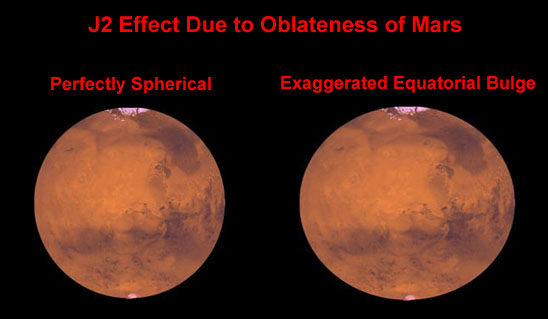

24-FEB-99 6:00 PM PST
Nav Team Report
MAPPING ORBIT (TMO) MANEUVER RESULTS AND PREDICTED ORBIT ELEMENT EVOLUTION
A very accurate initial mapping orbit has been established. The argument of periapsis is under the south pole, the semi-major axis is 0.4 km higher than the target value and the inclination may be 0.05 deg lower than desired. The first orbit trim maneuver (OTM-1 scheduled for 2/25/99 to correct the inclination) was canceled because of the accuracy achieved. OTM-2 and OTM-3 are scheduled for 3/12/99 and 4/1/99 respectively.
Figs. 5-8: These show the predicted trend of the following osculating orbit elements at apoapsis: orbital period, argument of periapsis, inclination and altitude at apoapsis passage. These cover A1483 (2/20/99, 17:29:34 ET) through A1963 (3/31/99, 22:53:34 ET). Angular quantities are referenced to Mars' mean equator.
Figs. 9-10: These show the predicted trend of the following osculating orbit elements at periapsis: eccentricity and altitude at periapsis passage. These cover P1484 through P1964.
Fig. 11 shows the progression of the local mean solar time (LMST) at the descending equator crossing. The slope is approximately -1 minute LMST over 39.2 days.
Fig. 12 gives the longitude (east) of the descending equator crossing for orbits 1483 through 1583. For the ideal 88 orbits over 7 sols sub-cycle, we would have a 58.6 km walk (eastward) after this first sub-cycle is completed. The current best estimate of the walk is 25.8 km eastward. This is dependent on the true gravity field as opposed to the current gravity field model used in our analysis.
NOTE: If the time scale on these figures were expanded then short-periodic trends would be visible instead of the apparent random variation. These are current results of the MSOP/MGS Navigation Team. GCO gravity results are a cooperative analysis between Navigation and the Radio Science Teams.
The TMO sequence that places the argument of periapsis over the South Pole was successfully completed. The Nav Team is in the process of achieving a stable orbit in which the argument of periapsis and local mean solar time vary slowly over the duration of the mapping phase. Correction burns will be periodically performed to maintain the desired orbital elements. The Nav Team will provide a detailed description of the current orbital status in tomorrow's gravity calibration report.
The TMO sequence that will place the argument of periapsis over the South Pole has been approved for transmission to the spacecraft. The TMO burn will occur tomorrow at approximately 2:15 PM PST. There will be a Spacecraft Team meeting tomorrow morning at 9:30 AM in the Control Room in order to discuss the next series of maneuvers.
MGS-MCO-MPL NAVIGATION FLIGHT OPERATIONS READINESS: 2/16/99 TO 8/1/99
We will treat the remainder of the gravity calibration period much like the last month of aerobraking, i.e. frequent updates.
The Nav Team is currently mapping out the gravity field of Mars in the region near the current orbit. The gravity field is not perfectly uniform due to the oblateness of Mars. The oblateness arises from a slight equatorial bulge due to the rotation of Mars. This gives rise to what is know in orbital mechanics as the J2 effect. It is this effect that is responsible for the precession of the orbital plane. By selecting the correct angle of inclination and the correct augment of periapsis, the Nav Team can achieve what is know as a "frozen sun synchronous orbit". However, before they can select the correct inclination and argument of periapsis they must map out the variation in the gravitational field.
 |
Over the next two weeks we will attempt to explain this process in greater levels of detail. For those who wish to understand in gory detail what we are doing, we recommend the following text:
Air Force Institute of Technology Wright Patterson Air Force Base, Ohio |
We will first explain things in layman's terms and then we give you the equations and graphs. Over the next 3 days we recommend you read up on orbital mechanics. There will be no further updates until Monday 15-FEB-99.